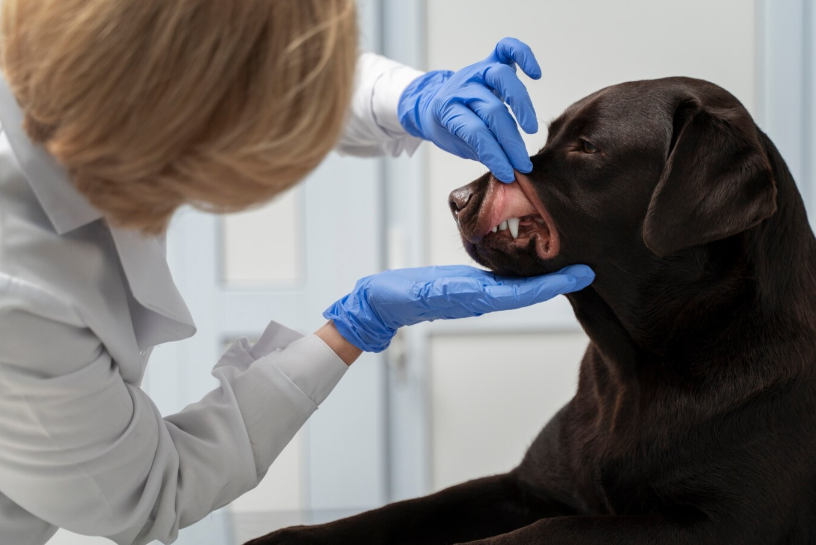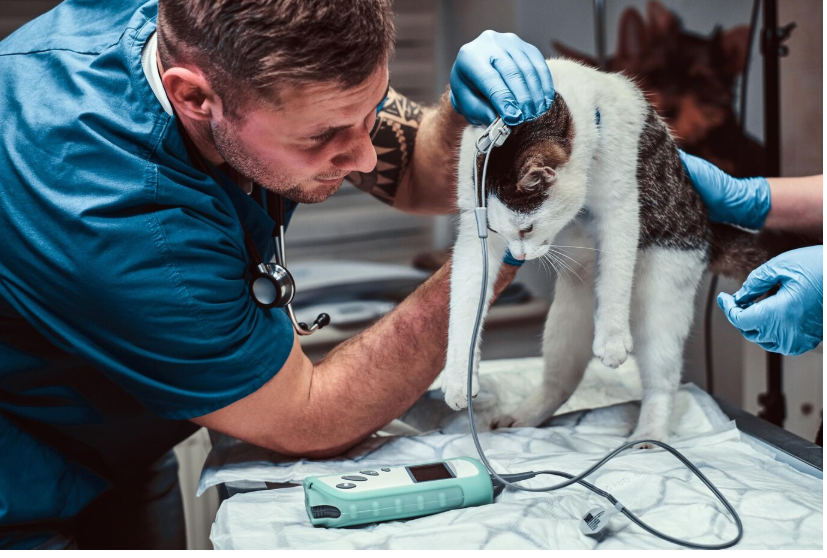Most pet insurance plans do not cover spaying because it is considered a routine, preventive procedure rather than a medical necessity. But, it helps pet owners manage unexpected medical costs, and cover accidents and illnesses.
In some cases, insurers offer wellness plans or preventive care add-ons that include spaying as part of routine care.
This article covers what pet insurance includes, what it excludes, and how to find pet insurance that covers spaying through special coverage options, and many more.
Why Does Pet Insurance Not Cover Spaying?
Spaying is an important procedure that offers pets several health and behavioral benefits. It helps prevent life-threatening diseases and eliminates the risk of unwanted litter.

Benefits Of Spaying Your Pet
- It prevents the risk of ovarian and uterine infections (such as pyometra) and cancers.
- It minimizes aggression, roaming tendencies, and excessive howling or yowling in female pets.
- It helps control pet overpopulation and reduces the number of stray animals.
- It reduces the risk of future medical conditions that could lead to expensive treatments.
Despite these benefits, pet insurance that covers spaying is limited. Below, we explain why spaying is not included in standard pet insurance and how to find a plan that consists of this procedure.
1. Standard Pet Insurance Policies
Most basic pet insurance plans do not cover spaying or neutering because these procedures are elective and not considered medical emergencies.
Insurance companies focus on unforeseen health issues like accidents, infections, or chronic diseases. Since spaying is a planned procedure that prevents future health problems, it is classified as preventive care and excluded from standard policies.
2. Exceptions & Special Cases
Some insurance providers may cover if a vet determines that spaying is medically necessary due to a serious health condition. For example:
- If a dog develops a reproductive disease, such as pyometra or ovarian tumors, spaying may be covered as part of the treatment.
- In rare cases, spaying might be included in accident-related coverage if a pet sustains an injury requiring the procedure.
Since these situations are uncommon, you must check your insurance provider’s terms before assuming coverage.
3. Insurance Companies That May Offer Spaying Coverage
Few pet insurers offer wellness plans or preventive care add-ons, including spaying and neutering. These plans cover routine veterinary expenses like vaccinations, dental cleanings, and annual check-ups.
Lemonade, Nationwide, and ASPCA are among the companies offering these optional plans. However, it is best to compare different wellness plans for your pet’s health.
By selecting the right plan, you can ensure your pet receives the necessary care while avoiding unexpected expenses.
What Does Pet Insurance Typically Cover?
Pet insurance ensures your pet gets the care they need without financial stress. But coverage depends on the provider and the plan you choose.

1. Accident Coverage
Pet insurance covers sudden injuries caused by accidents. This includes broken bones, cuts, and wounds from fights or falls. If your pet swallows an object or suffers a serious injury requiring emergency treatment or surgery, insurance helps cover the cost.
2. Illness Coverage
Most plans include coverage for chronic conditions like diabetes and heart disease. If your pet develops infections, respiratory illnesses, or digestive issues, insurance helps pay for diagnosis, treatment, and medications. However, diseases diagnosed before getting a policy are not covered.
2. Hereditary & Congenital Conditions
Some breeds are prone to genetic conditions like hip dysplasia, cataracts, or heart defects. Depending on the insurance provider, these conditions may be covered if not diagnosed before enrollment. Coverage often includes hospital stays, X-rays, MRIs, and prescription medications necessary for managing such conditions.
For more detailed information, you can refer to the Pet Insurance Statistics, which provides all the required pet data.
What Is Not Covered By Pet Insurance?
Pet insurance does not cover routine and elective procedures because it focuses on unexpected medical expenses. Understanding these exclusions helps pet owners choose the right plan.

1. Routine & Preventive Care
Most pet insurance plans do not include preventive treatments such as spaying, neutering, and vaccinations. These procedures are considered routine and require a separate wellness plan for coverage.
2. Pre-Existing Conditions
Any illness or injury your pet had before enrolling in insurance is usually excluded. For example, if your pet was diagnosed with arthritis, allergies, or kidney disease before coverage began, treatment costs will not be reimbursed. This is why it’s best to get pet insurance early in your pet’s life.
3. Elective & Cosmetic Procedures
The procedures, such as ear cropping, tail docking, and claw removal, are not covered which are not medically necessary. These treatments are considered cosmetic and are often performed for aesthetic reasons rather than health concerns.
4. Breeding & Pregnancy-Related Costs
Most insurance policies do not cover related expenses if your pet is used for breeding. This includes C-sections, pregnancy complications, fertility treatments, and artificial insemination. They offer limited coverage for pregnancy issues but usually require a separate plan.
Can You Get Spaying Covered Under Pet Insurance?
Pet owners can get spaying covered through wellness plans, bundled policies, employer-sponsored pet insurance, or veterinary payment plans.
1. Wellness Plans / Preventive Care Add-Ons
Here’s what you need to know about how Wellness Plans Cover Spaying & Neutering:

- Routine Surgeries Like Spaying & Neutering: These procedures help prevent health issues like infections and reproductive diseases. Without coverage, these surgeries can cost between $200 and $500 at private clinics.
- Includes Preventive Vet Visits & Vaccinations: Most wellness plans include regular checkups, flea and tick prevention, and deworming. These services keep your pet healthy and can cost an additional $100 to $250 per year without coverage.
- Saves Money on Common Vet Expenses: Instead of paying a large sum upfront, a wellness plan spreads the cost across monthly premiums. This makes budgeting for spaying and neutering easier and covers essential preventive treatments.
- Offered by Top Pet Insurance Companies: Companies like Lemonade, Nationwide, and ASPCA offer pet insurance that covers spaying and neutering through their wellness packages. These plans typically add $10 to $25 per month to your insurance cost.
- Best for Pet Owners Wanting Full Coverage: It covers essential vet services, making it easier to budget for routine care while preventing expensive medical issues in the future. Investing in pet insurance that covers spaying ensures a pet’s long-term health and well-being.
2. Bundled Policies
Some insurers offer premium plans that combine accident, illness, and wellness care into one policy. These bundled plans are more expensive but provide complete coverage, including preventive care like spaying.
Companies like Trupanion and Healthy Paws Pet Insurance may offer packages where you can add preventive coverage to an existing policy.
3. Employer-Sponsored Pet Insurance
Some companies offer employer-sponsored pet insurance as part of their benefits package. This coverage may include preventive care, such as spaying and neutering.
Providers such as MetLife Pet Insurance, Nationwide, and Fetch by The Dodo offer plans through select workplaces. These policies help employees save on vet costs while ensuring pets receive necessary medical care.
If your workplace offers pet insurance covering neutering, it’s worth checking which services are included and whether you need to pay extra for preventive care.
4. Veterinary Payment Plans & Discounts
Many veterinary clinics offer payment plans or discount programs. Some vets allow installments, helping pet owners manage costs without upfront expenses.
Low-cost clinics and animal welfare organizations also provide discounted spay/neuter services. Programs like ASPCA Spay/Neuter Alliance and Humane Society Low-Cost Clinics offer affordable options.
Checking with Banfield Pet Hospital or VCA Animal Hospitals can also help you find flexible payment options or wellness plans that include these procedures.
Cost of Spaying: Prices In Detail
Spaying costs vary based on location, vet clinic, and your pet’s size. While wellness plans can help with these costs, pet owners without coverage may need to pay out of pocket.
| Service Type | Cost Range |
|---|---|
| Low-Cost Clinics/Shelters | $50 – $150 |
| Private Veterinary Clinics | $200 – $300 |
| High-Cost Areas/Special Cases | $500 – $2000 |
Some cities have higher prices, while nonprofit clinics offer lower-cost options. You can look for pet insurance that covers neutering; wellness add-ons can significantly reduce the financial burden.
Price Source: The Dog People, Lemonade
Factors That Increase Spay Or Neuter Costs
Pet owners should consider these increased costs aspects before scheduling the surgery.
- Pet’s Size & Weight: Larger pets require more anesthesia and longer surgery time. Heavier dogs may also need higher doses of medication.
- Age & Health Condition: Older pets or those with medical conditions need extra care during surgery. Some may require pre-surgery tests or specialized monitoring.
- Location & Veterinary Clinic: Urban clinics and high-end veterinary hospitals tend to have higher rates than rural or nonprofit clinics.
- Pre-Surgery Tests & Medications: Some vets recommend blood tests, pain relief medications, or IV fluids before surgery to ensure the pet’s safety.
- Additional Procedures: Pets with complications like undescended testicles, infections, or pregnancy may need extra surgical steps for a successful procedure.
Alternative Ways To Save on Spaying Costs
Spaying can be costly, but several options help pet owners reduce expenses. Many resources offer financial assistance or discounted services, from low-cost clinics to government programs to make spaying affordable.

1. Low-Cost Clinics & Animal Welfare Organizations
Humane Societies and organizations like the ASPCA provide reduced-cost spaying services. These clinics operate to control pet overpopulation and ensure accessible care.
Some animal shelters also offer low-cost sterilization services for adopted pets. To find affordable options, check with local shelters or welfare groups.
2. Local Government Programs
Some states and cities offer financial assistance for spaying through government programs. For example, New York City’s ASPCA Mobile Spay/Neuter Clinic provides low-cost services, while California’s Pet Lover’s License Plate Program funds affordable sterilization.
Local animal control agencies may partner with veterinarians to offer subsidized procedures for low-income pet owners.
3. Non-Profit and Rescue Organizations
Nonprofits like the Friends of Animals Spay/Neuter Program and The SpayUSA Network help reduce spaying costs through vouchers or direct funding.
Rescue groups often collaborate with veterinary clinics to offer adopted pets free or discounted sterilization. Many breed-specific rescues also assist with spaying costs to ensure responsible pet ownership.
4. Vet Schools Offering Discounted Procedures
Veterinary colleges often provide low-cost spaying services as part of their student training programs.
Schools like Texas A&M College of Veterinary Medicine and the University of Florida College of Veterinary Medicine allow supervised students to perform surgeries at lower rates. These programs maintain high standards while offering an affordable alternative for pet owners.
Conclusion: Pet Insurance Does Not Cover Spaying
Standard pet insurance doesn’t cover spaying, but wellness plans can. You can also go through the bundled policies or employer-sponsored plans to save costs with your pet’s essential care.
There are various ways, though, such as low-cost clinics, government programs, nonprofit assistance, and veterinary schools offering discounted procedures, so it’s best to check at your location.
Get the best coverage for your pet’s needs, which can be covered in an Insurance Plan.
FAQs
The cost of spaying a dog varies based on location, clinic type, and the dog’s size. Low-cost clinics charge $50–$150, while private vets typically charge $200–$300. In high-cost areas or special cases, prices can go up to $500 or more.
Pet insurance is worth it if you want financial protection against unexpected vet bills. It helps cover accidents, illnesses, and emergencies, reducing out-of-pocket expenses and ensuring your pet gets timely medical care.
Pet insurance plans do not cover spaying for cats, as it is considered preventive care. However, some pet insurance that covers spaying is available through wellness plans from providers like Nationwide, Lemonade, and the ASPCA, which include spaying as part of routine care coverage.
Neutering and spaying are both sterilization procedures, but they are different. Spaying is the surgical removal of a female pet’s ovaries and uterus, while neutering (castration) involves removing a male pet’s testicles. Both prevent reproduction and offer health benefits for pets.
The ideal age to neuter a dog depends on its breed and size. Small dogs can be neutered as early as 6 months, while large breeds may benefit from waiting until 12–18 months to allow full growth. Always consult your vet for the best timing.
